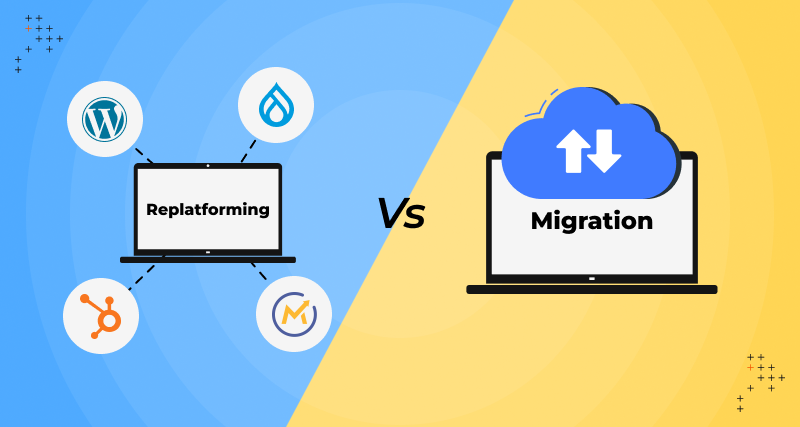Introduction
Businesses are shifting their focus on using a reliable CMS that can elevate the website's functionality. As high-traffic websites have immensely used Drupal, many companies are now considering content migration to this open-source CMS platform for providing the best digital experiences to customers.
But without the right strategies in place, everything can fall apart quickly. This is why businesses must have a solid plan for executing a content migration in Drupal.
What Is Content Migration?
Content migration is an upgrade process in which data is transferred from one source like Drupal 7 to another site. This migration process helps automate the tedious task of copying and pasting the required data. A content migration involves configuring file types, user roles, content types, nodes, and taxonomy terms.
Content Migration And Data Integrity
When a website’s version becomes outdated, changes must be made within the database to accommodate the updated code. The key factors to consider during the upgrade include SEO and accessibility.
Elements like meta descriptions and alt text determine the accessibility of the site to the users. This is why maintaining and updating data integrity is one of the crucial tasks under site migration. Businesses must avoid piling up content migration tasks and perform them wisely.
Requirements For Content Migration
Following prerequisites can help businesses deliver a more powerful, robust, and flexible digital experience.
- Save time and effort during content migration by eliminating unused and irrelevant content.
- Avoid complications during migration by ensuring smooth access to the current website’s database and files
- Create a backup of the current website.
- Download the fresh installation of Drupal 9 and enable core Migrate modules.
- Become familiar with the Drupal 9 migration system to avoid possible complications.
- Choose a migration path: Drush or the browser user interface.
- Utilize the flexibility of the Drupal content migration system and extract content from older versions of Drupal or sources like CSV, XML, JSON, and MySQL.
Start With A Solid Plan
The upgrade might take time, depending on the content size and configuration of the source site. It can be performed manually If the number of nodes is small. But it becomes quite tedious if it amounts to hundreds, thousands, or millions of nodes. This is why it is essential to be prepared in advance.
Follow the steps to plan the required execution.
- Identify the content types and structures of the existing site and document the observations.
- Identify a list of required modules and check if Drupal 9 versions of those modules are available or if the modules have been moved to the Drupal 9 Core.
- Replicate the content types, taxonomies, and other required entities in Drupal 9. The views can be built manually later. This step provides greater flexibility to tweak the content architecture and refactor content types and taxonomy per usage.
But what if you want to migrate the entire content configuration at once?
In that case, execute the following command.

Use the following command to manage the entire content migration.

Another option is available for businesses that don’t want to consider bulk import migration. In this case, ensuring the correct order while performing migrations is vital. Here, the order should be:
Content: Files<Terms<Users<Paragraphs<Nodes
Configuration: Vocabularies<Content Types<User Roles<Fields<Image Styles
A Quick Tale: Performing Seamless Content Migration To Drupal For Lonely Planet
Lonely Planet, a well-known name in the travel industry, aims to offer insightful resources for travelers to various destinations worldwide. But it was difficult to achieve this goal when the website faced issues with caching and scalability. The fact that the legacy website was a decade old and was custom built on Ruby on Rails didn’t help either.
Content migration to Drupal and Acquia could solve the problem, but the experienced in-house team at Lonely Planet was new to Drupal. They needed help to execute the migration seamlessly.
The experts at Axelerant helped Lonely Planet streamline its content migration process and gain hands-on experience in the platform.
The Migration Modules
Drupal 9 has migration modules like migrate, migrate_drupal, migrate_drupal_multilingual, and migrate_drupal_ui in its core. The Migrate module provides a framework to migrate content from various sources to Drupal 9.
For Drupal to Drupal migrations, developers need to use the migrate_drupal.module. Together, these modules provide overall migration support to migrate the content from Drupal 7 sites to Drupal 9.
Apart from these modules, developers might need to implement a custom migration path for the contributed modules. A good place to start is by reviewing data of contributed modules and writing a migration path for those modules.
Modules like Migrate Drupal UI provide UI support to review migrations. It offers various features like credential support to provide source database credentials, an overview form, and other necessary features to run the migrations via UI.
Roadmap To Ensuring Seamless Content Migration To Drupal 9
Several steps must be taken to ensure a successful content migration to Drupal 9. These steps are given below.
Step 1: Define Clear Goals
Consider the strategic goals and priorities of the organization before planning content migration. Evaluate how the new website could support those goals and build measurable success metrics.
Outlining these measurables at the beginning of a project plays a key role in maintaining focus. It’s essential to set SMART goals.
- Specific: Set a clear and concise description of your goal.
- Measurable: Define a metric that includes a target to measure success.
- Achievable: Include a challenge that should be realistic.
- Relevant: Ensure the goals resonate with the big picture.
- Time-Bound: Set a particular date for the achievement of the intended goal.
Step 2: Conduct Research And Content Audit
Understanding the customers' needs and what they expect from the website is imperative. Organizations can gain insights into customer preferences by asking the right questions through surveys, focus groups, interviews, and card sorting techniques.
Based on the results, a ROT (Redundant, Outdated, and Trivial) analysis can be performed before starting with content migration. To evaluate the content successfully, follow the TRUST technique.
- Timely: Check if the information is latest and up-to-date. If it is, don’t rewrite it. Instead, consider repurposing it to draw more attention through social media.
- Relevant: Ask if the information is relevant enough for the end-users.
- Understandable: The volume of online content can sometimes be a matter of concern. Consider breaking down the content into different points, infographics, and various small articles to make it simple.
- Significant: By leveraging page view statistics, keep an eye on the traffic that the web pages of the website are getting. If web pages do not get enough traffic, consider repurposing the content with more direct and user-friendly language.
- Targeted: Ask if the content is targeting the right customer base.
Step 3: Define The Content Types
The structures of the content types and source files have a significant role in importing. It’s advised to define the content types before coding. Equally, prioritize the relationships that exist between different content types and taxonomies.
Step 4: Hire A Drupal Expert For Assistance
Consider partnering with a renowned Drupal development agency If the in-house team needs help managing content migration. By taking help from a team of proficient Drupal experts, organizations can seamlessly attain their goals and accomplish the project’s vision.
Look for an experienced firm equipped with Acquia-certified Drupal developers and a high rating in the Drupal marketplace.
Step 5: Regular Testing Is The Key To Success
When content migration is automated, content or data may be lost during the transfer. So it's imperative to ask content editors and internal site users to keep an eye on the missing content or broken entities to log and fix such issues.
Continuous testing helps to ensure that the content to the new website is migrated properly without putting entire operations to a halt.
The Conclusion
The content migration to Drupal 9 can be done seamlessly if an organization has access to the right talent. Most tasks can be automated and easily manageable with ready-to-use modules.
The experts at Axelerant take care of the technical work and draw the ideal way of achieving success by focusing on your business core. By offering best-in-class Drupal development services, the proficient team at Axelerant will help you smoothly transition to the most popular enterprise-ready content management system.
Get in touch with us today to fulfill your content migration goals!

Simran Sethi, Marketing Manager
Simran is an avid reader. She is an active runner, who also likes to swim, dance, and sing. For her, the meaning of life lies in the little things. Kindness, passion, and compassion are her life’s essential values.
 We respect your privacy. Your information is safe.
We respect your privacy. Your information is safe.



Leave us a comment